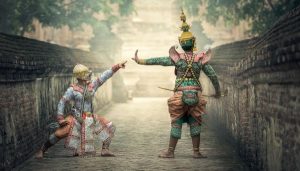
As the world progressed, governments no longer needed the special skillsets of the ninja to maintain control of Japan. Throughout the Edo period, demand for ninja’s covert abilities declined. The Shimabara revolt, orchestrated by Christian peasants in the seventeenth century, served as the last conflict where ninjas played an active battlefield role. Faced with the growing discontent of the Christian peasants, Shogun Tokugawa Iemitsu gathered a large army, supported by Koga ninjas, to crush the rebellion. Eventually, the government army forced the Christian rebels into a last stand at Hara Castle. The Koga used their expertise in stealth to view the defenses, capture enemy provisions, and steal a banner barring the Christian cross. Despite their accomplishments, their overall contribution to the campaign was limited, further facilitating the ninja’s decline.
Despite their limited use, it was not until Japan ended their exclusionist policy that the ninja truly faded into the annals of history. The last officially assigned ninja mission in public record coincides with the arrival of commodore Mathew Perry and his ‘black ships’ to Japan. The Americans arrived with the intention of intimidating the Japanese government into establishing trade relations with the rest of the world. Aware of the danger posed by the technologically advanced ships, the Japanese decided to first investigate Perry’s true intentions by sending a ninja aboard his ships. After consulting with the leaders of the Iga clans, the skillful Sawamura Jinzaburo was selected to conduct the mission.
Sawamura, dressed as an ordinary government worker, successfully boarded one of the American ships, slipping into the shadows, and began searching for important documents. The Japanese government waited tensely for Sawamura’s return, thoughts of Perry’s outrage if he discovered the ninja aboard his ship flitting through their minds. But Sawamura returned unharmed and undetected. With him he brought bread, candles, tobacco, and, most importantly, documents. When translated, however, the documents turned out to be bawdy Dutch lyrics extolling the bedroom and kitchen merits of French and British women. While a telling sign of Sawamura’s linguistic limitations, the Japanese government still decided the lack of substantial evidence of malicious intent was enough reason to grudgingly trust the Americans. Soon afterwards, Japan opened itself to the world.
The Sawamaru family archives, located in Iga-Ueno city, still showcase the two documents stolen by their ancestor. Although no longer officially employed by the government, the ninja families continued to practice the art of ninjutsu. By passing down from generation to generation scrolls filled with secret techniques, the ninja managed to keep their art alive. In addition to writings, family members in the mountains passed down oral traditions of ninjutsu to disciples and sons to keep the art from fading. In the 19th century Masaaki Hatsumi, known as the 34th grand master, began teaching ninjutsu to the general public. Inspired by tales Sawamura’s daring, schools teaching ninjitsu spread across the world from East to West.




Free 2-Day Shipping!
all USA orders